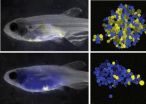(Press-News.org) An international group led by Vanderbilt University researchers has found cannabinoid receptors, through which marijuana exerts its effects, in a key emotional hub in the brain involved in regulating anxiety and the flight-or-fight response.
This is the first time cannabinoid receptors have been identified in the central nucleus of the amygdala in a mouse model, they report in the current issue of the journal Neuron.
The discovery may help explain why marijuana users say they take the drug mainly to reduce anxiety, said Sachin Patel, M.D., Ph.D., the paper's senior author and professor of Psychiatry and of Molecular Physiology and Biophysics.
Led by first author Teniel Ramikie, a graduate student in Patel's lab, the researchers also showed for the first time how nerve cells in this part of the brain make and release their own natural "endocannabinoids."
The study "could be highly important for understanding how cannabis exerts its behavioral effects," Patel said. As the legalization of marijuana spreads across the country, more people — and especially young people whose brains are still developing — are being exposed to the drug.
Previous studies at Vanderbilt and elsewhere, Patel said, have suggested the following:
The natural endocannabinoid system regulates anxiety and the response to stress by dampening excitatory signals that involve the neurotransmitter glutamate.
Chronic stress or acute, severe emotional trauma can cause a reduction in both the production of endocannabinoids and the responsiveness of the receptors. Without their "buffering" effect, anxiety goes up.
While marijuana's "exogenous" cannabinoids also can reduce anxiety, chronic use of the drug down-regulates the receptors, paradoxically increasing anxiety. This can trigger "a vicious cycle" of increasing marijuana use that in some cases leads to addiction.
In the current study, the researchers used high-affinity antibodies to "label" the cannabinoid receptors so they could be seen using various microscopy techniques, including electron microscopy, which allowed very detailed visualization at individual synapses, or gaps between nerve cells.
"We know where the receptors are, we know their function, we know how these neurons make their own cannabinoids," Patel said. "Now can we see how that system is affected by … stress and chronic (marijuana) use? It might fundamentally change our understanding of cellular communication in the amygdala."
INFORMATION:The research team included scientists from Hokkaido University in Sapporo, Japan, the Hungarian Academy of Sciences in Budapest, and Indiana University in Bloomington.
Discovery sheds new light on marijuana's anxiety relief effects
2014-03-06
ELSE PRESS RELEASES FROM THIS DATE:
Some people really just don't like music
2014-03-06
It is often said that music is a universal language. However, a new report in the Cell Press journal Current Biology on March 6 finds that music doesn't speak to everyone. There are people who are perfectly able to experience pleasure in other ways who simply don't get music in the way the rest of us do.
The researchers refer to this newly described condition as specific musical anhedonia—in other words, the specific inability to experience pleasure from music.
"The identification of these individuals could be very important to understanding the neural basis of music—that ...
'Seeing' bodies with sound (no sight required)
2014-03-06
People born unable to see are readily capable of learning to perceive the shape of the human body through soundscapes that translate images into sound, according to researchers who report their findings in the Cell Press journal Current Biology on March 6. With a little training, soundscapes representing the outlines and silhouettes of bodies cause the brain's visual cortex—and specifically an area dedicated in normally sighted people to processing body shapes—to light up with activity.
With no more than 70 hours of training on average, study participants could recognize ...
Common mutation is culprit in acute leukemia relapse
2014-03-06
Harvard stem cell scientists have identified a mutation in human cases of acute lymphoblastic leukemia that likely drives relapse. The research, published in Cancer Cell, could translate into improved patient care strategies for this particular blood cancer, which typically affects children but is more deadly in adults.
In recent years, a trend toward single-cell analysis has shown that individual cells within a tumor are capable of amassing mutations to make them more aggressive and treatment resistant. So while 99% of a tumor may be destroyed by the initial treatment, ...
Warming temperatures are pushing 2 chickadee species -- and their hybrids -- northward
2014-03-06
The zone of overlap between two popular, closely related backyard birds is moving northward at a rate that matches warming winter temperatures, according to a study by researchers from the Cornell Lab of Ornithology, Villanova University, and Cornell University. The research will be published online in Current Biology on Thursday, March 6, 2014.
In a narrow strip that runs across the eastern U.S., Carolina Chickadees from the south meet and interbreed with Black-capped Chickadees from the north. The new study finds that this hybrid zone has moved northward at a rate ...
Obese adolescents not getting enough sleep?
2014-03-06
Cincinnati, OH, March 6, 2014 -- Lack of sleep and obesity have been associated with an increased risk of cardiovascular and metabolic diseases in adults and young children. However, the association is not as clear in adolescents, an age group that is known to lack adequate sleep and have an overweight and obesity prevalence rate of 30% in the US. In a new study scheduled for publication in The Journal of Pediatrics, researchers found that cardiometabolic risk in obese adolescents may be predicted by typical sleep patterns.
Heidi B. IglayReger, PhD, and colleagues from ...
Establishing standards where none exist; Harvard researchers define 'good' stem cells
2014-03-06
After more than a decade of incremental – and paradigm shifting, advances in stem cell biology, almost anyone with a basic understanding of life sciences knows that stem cells are the basic form of cell from which all specialized cells, and eventually organs and body parts, derive.
But what makes a "good" stem cell, one that can reliably be used in drug development, and for disease study? Researchers have made enormous strides in understanding the process of cellular reprogramming, and how and why stem cells commit to becoming various types of adult cells. But until now, ...
Dr. Brenna Anderson contributes to expert series on GAS in pregnancy
2014-03-06
Ignaz Semmelweiss made one of the most important contributions to modern medicine when he instituted hand washing in an obstetric clinic in Austria in 1847, decreasing mortality there from more than ten percent to two percent. Unfortunately, infections can still occur in pregnancy and during delivery and can have associated mortality rates of up to 30 to 50 percent if not treated quickly and properly.
Brenna Anderson, MD, director of the Women's Infectious Diseases Consultative Service at Women & Infants of Rhode Island and an associate professor of obstetrics and gynecology ...
Study identifies gene important to breast development and breast cancer
2014-03-06
Significance: Understanding more about how the different types of cells in breast tissue develop improves our knowledge of breast cancer. TAZ represents a potential new target for drug therapies to treat aggressive types of breast cancer.
Background: In cancer, normal cells can become unpredictable or aggressive and thus difficult to treat with anti-cancer drugs. This is especially true in breast cancer. By identifying the genes responsible for this change in cells from breast tissue, researchers hope to identify a way to stop or reverse it.
In breast tissue, there ...
Are you smarter than a 5-year-old? Preschoolers can do algebra
2014-03-06
Millions of high school and college algebra students are united in a shared agony over solving for x and y, and for those to whom the answers don't come easily, it gets worse: Most preschoolers and kindergarteners can do some algebra before even entering a math class.
In a recently published study in the journal Developmental Science, lead author and post-doctoral fellow Melissa Kibbe and Lisa Feigenson, associate professor of psychological and brain sciences at Johns Hopkins University's Krieger School of Arts and Sciences, find that most preschoolers and kindergarteners, ...
Access to social workers could keep veterans out of criminal justice system, MU researchers find
2014-03-06
COLUMBIA, Mo. –Approximately one in six veterans struggles with substance abuse, and 20 percent show signs of mental health issues or cognitive impairments, previous research has shown. These risk factors, combined with a lack of resources, could be contributing to an increase of veterans entering the criminal justice system, according to a report by the Center for Mental Health Services. Now, University of Missouri researchers have investigated ways social workers can address veterans' needs and keep them out of jail.
"Social workers are equipped to provide support to ...


